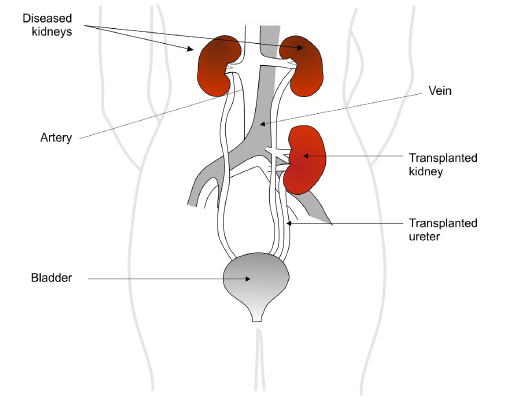The kidney transplant operation
The operation is performed under a general anaesthetic. During the operation, a special intravenous drip called a central venous line will be inserted. This is placed into a large vein in the neck and is used for giving fluid and medications. It is usually removed on day 4 after the transplant.
In addition, a catheter (soft silicon tube) is inserted into the bladder - its function is to drain urine from the bladder. This is to monitor how much urine the kidney is making. The catheter can irritate the lining of the bladder, sometimes giving the feeling that the bladder is not emptying and may be a little uncomfortable. The catheter usually comes out a few days after the operation.
The operation is performed through a cut in the lower abdomen just above the groin. The kidney has 2 main blood vessels, an artery where blood travels into the kidney before it is filtered, and a vein for returning filtered blood back into the circulation. Usually, the new kidney artery is joined onto the artery that provides the blood supply down the patient's leg. The kidney vein is joined to the main vein in the pelvis that carries blood from the leg.

After the blood vessels have been joined, the ureter (the tube that carries the urine from the kidney to the bladder) is then joined to the bladder. A stent (a small plastic tube) is placed inside the ureter between the transplanted kidney and the bladder to help with this part of the operation. The stent reduces the chance of the ureter becoming blocked or urine leaking from the join between the ureter and the bladder. The stent is removed about three to six weeks after the surgery. This involves a second minor procedure using a telescope that is inserted into the bladder (cystoscopy).
In male patients it may very occasionally be necessary to divide the vas deferens (the tube draining the sperm from the testicle) on the side of the operation to enable the kidney to be positioned correctly. This results in a vasectomy on the affected side. The vas deferens on the side opposite of the transplant, however, is not affected and so fertility is usually preserved. It is important to notify the surgeon if you have had any damage or disease of the testicles.
Small plastic tubes (drains) are inserted into the wound to ensure that blood or serum will not collect around the kidney. The muscles and skin are then closed over the kidney and the patient is transferred to the recovery area. The drains are removed a couple of days after the surgery.
Overall the operation usually takes 3 to 4 hours, but you will be away from the ward for much longer than that, typically 7-8 hours. Everything needs to be checked before you leave the operating theatre complex and return to the ward.
Your own kidneys are not removed.


